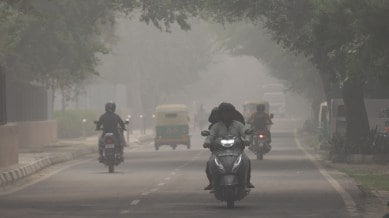Stay updated with the latest - Click here to follow us on Instagram
Haze over Delhi-NCR as calm winds, rising ozone push air quality deeper into ‘very poor’ range
Delhi weather: increased stubble burning in neighbouring states, along with festive traffic and firecracker use, has contributed to a rise in Delhi's pollution levels.

A thick layer of haze blanketed Delhi-NCR Thursday morning as calm winds and rising ground-level ozone pushed air quality deeper into the ‘poor’ and ‘very poor’ range. Noida and parts of East and Outer Delhi saw the sharpest spikes in PM2.5 concentrations, data from the Central Pollution Control Board (CPCB) showed.
At 10 am, the Air Quality Index (AQI) at Anand Vihar stood at 362, Dwarka Sector-8 at 327, and Wazirpur at 330, placing them in the ‘very poor’ category.
monthly limit of free stories.
with an Express account.
In neighbouring Noida, air quality was worse, with Sector 125 recording an AQI of 348 and Sector 116 at 325, compared to Delhi’s citywide average hovering around the ‘poor to very poor’ threshold. In Faridabad, most stations reported AQI in the ‘moderate’ range.
A comparison of data from the previous morning shows a steady uptick across the city. For instance, AQI at Anand Vihar rose from 335 to 362, Dwarka Sector-8 from 302 to 327, and Wazirpur from 323 to 330.
Reasons for worsening AQI
The increase is consistent with the post-monsoon transition, when dropping temperatures, high humidity, and low wind speeds combine to trap pollutants near the surface. An increase in stubble burning cases in neighbouring states, along with festive-season traffic and firecracker use, has also added to the city’s pollution load.
According to data from the Indian Agricultural Research Institute, 688 burning events were detected in six states, with the highest number occurring in UP at 271, followed by Punjab at 176.
According to the India Meteorological Department (IMD), calm winds persisted through Wednesday morning, limiting pollutant dispersion. Over the past 24 hours, westerly winds have been around 10 kmph.
Since October 10, ground-level ozone has emerged as the major pollutant across several parts of Delhi-NCR, according to the CPCB. Ozone is a secondary pollutant formed when sunlight reacts with nitrogen oxides and volatile organic compounds from vehicles and industries.
Traffic congestion across the city on Wednesday has also added to the pollution burden. Commuters were stuck for over two hours on the Ring Road stretch between Moolchand and AIIMS after a crane broke down near the Andrews Ganj flyover, according to the Delhi Traffic Police. Gridlocks were also reported from several other parts of the capital, including Mathura Road near Pragati Maidan, Outer Ring Road, and Netaji Subhash Place and Madhuban Chowk in northwest Delhi.
Forecast for Delhi
According to the System of Air Quality and Weather Forecasting and Research (SAFAR), Delhi’s overall AQI is likely to stay in the ‘poor’ range for the next two days, with a possible shift into ‘very poor’ by the weekend as humidity and calm conditions persist.
The IMD has forecast mist or haze during morning hours for the next two days, followed by smog or shallow fog between October 19 and 21, and hazy afternoons.